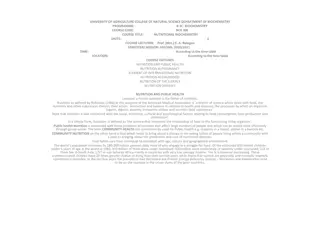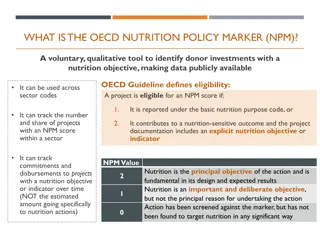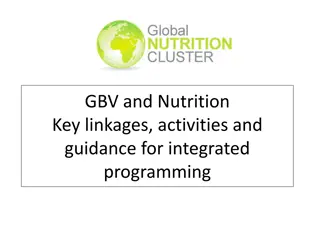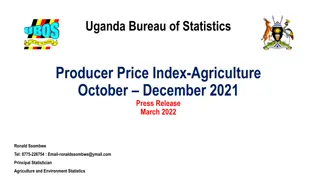Understanding Glycaemic Index in Nutrition and Health
Glycaemic Index (GI) measures how carbohydrate-containing foods affect blood glucose levels. High GI foods raise blood glucose rapidly, while low GI foods release glucose gradually. Studies track impacts on blood glucose levels, insulin secretion, fat storage, and pancreatic function. High GI foods elevate glucose and insulin levels quickly, stimulating fat storage and hunger. In contrast, low GI foods maintain steady energy levels without triggering fat storage mechanisms.
Download Presentation

Please find below an Image/Link to download the presentation.
The content on the website is provided AS IS for your information and personal use only. It may not be sold, licensed, or shared on other websites without obtaining consent from the author. Download presentation by click this link. If you encounter any issues during the download, it is possible that the publisher has removed the file from their server.
E N D
Presentation Transcript
Nutrition and Health Glycaemic Index
Topics What is Glycaemic Index? Studies of Glycaemic Index Effects of High and Low Glycaemic Index Foods Examples of High and Low Glycaemic Index Foods Factors Affecting the Glycaemic Index of a Food Item Other Considerations 2
What is Glycaemic Index? The glycaemic index (GI), measures how a carbohydrate-containing food raises blood glucose. Foods are ranked based on how they are compared to a reference food either glucose or white bread. Foods with carbohydrates which are digested and metabolised quickly tend to have a high GI. Glucose is released into the bloodstream rapidly. Foods with carbohydrates which are digested slowly and release glucose more gradually into the bloodstream have a low GI. A food item with a high GI raises blood glucose quicker than a food item with a medium or low GI. 3
What is Glycaemic Index? 5 4 High GI Blood Glucose (mM) Low GI 3 2 1 0 0 15 30 45 60 75 90 105 120 Time (min) Adapted from: Studio34 at English Wikipedia / Public domain 4
Hypothetical effect of feeding diets with a low (A) or high (B) glycemic index on gastrointestinal glucose absorption and postprandial blood glucose. Source: Glycemic index: overview of implications in health and disease
Studies of Glycaemic Index The four major areas that are tracked during glycaemic clinical studies include how the ingested food: 1. raises blood glucose levels 2. affects insulin secretion 3. stimulates lipoprotein lipase (LPL) and fat- storage mechanisms 4. affects the pancreas 6
Effects of High and Low Glycaemic Index Foods High glycaemic index foods Elevate blood glucose and insulin levels Provide energy to the body in a short period of time Rapid fall of blood glucose after the effect of insulin, triggering hunger sooner Stimulate fat-storage Low glycaemic index foods Do not overly elevate blood glucose and insulin levels Slow and gradual release of sugar into blood Maintain increased energy levels for a longer duration Do not stimulate lipoprotein lipase (LPL) and fat-storing mechanisms 7
Effects of High and Low Glycaemic Index Foods Carbohydrate-containing food raises blood glucose differently, using glucose (GI:100)as a reference, foods are divided into three categories: Low GI (55 or less) Medium GI (56-69) High GI (70 or more) 8
Examples of High and Low Glycaemic Index Foods Low GI (55 or less) Medium GI (56-69) High GI (70 or more) Rice Brown rice, black kernel rice Red rice (boiled), brown rice (boiled) Glutinous rice (boiled), white rice (boiled) Noodles Vermicelli, spaghetti, macaroni, egg noodles Udon Regular wheat noodles Bread Pumpernickel Pita bread, croissant White bread, steamed buns Breakfast cereals All bran, muesli, oat bran Bran with raisins Cornflakes, rice crispy, cocoa rice crispy Roots and tubers Corn, konjac Sweet potato, baked potato with skin Mashed potato, pumpkin Sugars Fructose, lactose, sugar alcohol Sucrose, honey Glucose, sugar, maltose Milk Skimmed/low fat milk Fruits Orange, apple, snow pear, grape, kiwi, pomelo, strawberry Soya beans, mung beans, black- eyed beans, red kidney beans, lentils Honeydew melon, banana, papaya, mango Baked beans Watermelon, lychee, longan Beans 9 Source: Diabetes Hongkong
Factors affecting the Glycaemic Index of a Food Item Fat and fibre tend to lower the GI of a food item. In general, when a food item is cooked for a longer time or has undergone a lot of processes, it may have a higher GI; however, this is not always true. Factors that can affect the GI of a food item, for example: ripeness and storage time: the more ripe a fruit or vegetable is, the higher the GI processing: fruit juice has a higher GI than whole fruit; mashed potato has a higher GI than a whole baked potato; stone ground whole wheat bread has a lower GI than whole wheat bread cooking method: how long the food is cooked (al dente pasta has a lower GI than soft-cooked pasta) variety: long-grain white rice has a lower GI than brown rice but short-grain white rice has a higher GI than brown rice 10
Other Considerations The amount of carbohydrates in food can affect blood glucose levels directly. Glycaemic Load (GL) is used to estimate the effect of actual intake of carbohydrates on blood glucose levels. Portion sizes and total calories should be considered when managing blood glucose. 11
Other Considerations The GI of a food item may vary, depends if it is eaten alone or combined with other foods. When eating a high GI food item, it can be combined with other low GI foods to balance out the effect on blood glucose levels. 12
Other Considerations Some foods that are low in GI should not be eaten in excess, for example: fructose fat protein A diet low in carbohydrates may in turn raises the percentage of intake from fat and protein, which may also affect the normal metabolism in the body. 13
Other Considerations There is no one diet or meal plan that works for everyone. People with diet-related issues should consult their dietitians for a meal plan that is suitable for an individual to attain healthy eating habit. 14
References Augustin, L., Kendall, C., Jenkins, D., Willett, W., Astrup, A., Barclay, A. (2015). Glycemic index, glycemic load and glycemic response: An International Scientific Consensus Summit from the International Carbohydrate Quality Consortium (ICQC). Nutrition, Metabolism and Cardiovascular Diseases,25(9), 795-815. doi:10.1016/j.numecd.2015.05.005 Diabetes Hongkong "Glycemic Index Defined". Glycemic Research Institute Jenkins, David J A, Kendall, Cyril W C, Augustin, Livia S A, Franceschi, Silvia, Hamidi, Maryam, Marchie, Augustine, Axelsen, Mette. (2002). Glycemic index: Overview of implications in health and disease. The American Journal of Clinical Nutrition, 76(1), 266S-73S. Studio34 at English Wikipedia / Public domain. 15























